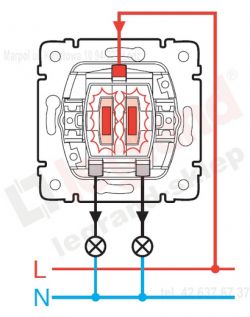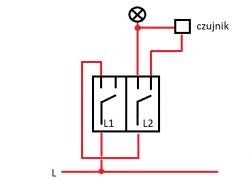FAQ
TL;DR: Use a 2‑circuit “candlestick” switch to split sensor and manual feeds; “one button you turn on the lighting on the detector and with the other button permanently.” Ideal for simple auto, manual‑on, and off control on terraces and entries. [Elektroda, tomek_wlkp, post #17156118]
Why it matters: It gives hands‑free lighting when away, manual control when home, and a quick way to disable nuisance triggers.
Quick Facts
- A two‑gang “candlestick” switch drives two independent circuits: sensor feed on one key, direct lamp feed on the other. [Elektroda, tomek_wlkp, post #17156118]
- Power‑cycling a PIR can cause brief “burn‑in” illumination; avoid using its supply as the override path. [Elektroda, wodzu_1, post #17156153]
- Most detectors use a relay output, so a parallel manual feed will not short or harm the sensor. [Elektroda, tomek_wlkp, post #17449683]
- STEINEL IS 360‑3 supports candlestick or stair‑switch wiring for permanent‑on and sensor‑auto modes. [STEINEL IS 360-3 Manual]
- Bistable relays add timed auto‑off and memory; a ~3‑second press enables permanent‑on, press again to turn off. [Elektroda, wodzu_1, post #17156153]
How do I wire a motion sensor with manual override using a two-gang switch?
Use a candlestick (two‑gang) switch. 1) Feed Line to both switch inputs. 2) Key A output to the sensor’s L; sensor’s switched output to the lamp. 3) Key B output directly to the lamp for permanent‑on. This yields auto, manual‑on, and all‑off modes. [Elektroda, tomek_wlkp, post #17156118]
Is it safe if the manual phase and the sensor phase meet at the lamp simultaneously?
Yes, both feeds are the same phase from the same circuit. It won’t fight or short. “After all, you connect the same phase there, so everything will be fine.” Keep neutrals common and protected by one breaker. [Elektroda, stanislaw1954, post #17156323]
Should I cut power to the motion sensor to force the light off?
Avoid using sensor power as your main override. Power‑cycling PIRs often triggers brief “burn‑in” illumination. Leave the sensor powered and override by switching the lamp line instead. This prevents nuisance flashes at night. [Elektroda, wodzu_1, post #17156153]
How can I add timed auto-off and permanent-on without smart home gear?
Use a bistable relay with a timer. Press to toggle on; press again to turn off. Hold about 3 seconds for permanent‑on. Choose a version with memory to restore the last state after outages. It simplifies control with one low‑voltage button. [Elektroda, wodzu_1, post #17156153]
Can a double stair switch both cut power and choose sensor/manual modes?
Yes, if your sensor uses a relay output. One key can isolate the system upstream. The other key can route power either through the sensor or directly to the lamp. Relay outputs tolerate the parallel feed without damage. [Elektroda, tomek_wlkp, post #17449683]
Will backfeeding voltage into a STEINEL IS 360-3 sensor output damage it?
No, the manufacturer’s diagrams show candlestick and stair‑switch overrides. These allow a direct lamp feed in parallel with the sensor output. That indicates the device is designed for such control methods. Follow the manual’s wiring options. [STEINEL IS 360-3 Manual]
I can’t find an I‑0‑II wall switch—what should I buy?
Buy a standard two‑gang “candlestick” switch. It provides two independent circuits for the sensor feed and the lamp’s direct feed. This is the recommended, simple wall solution for manual override with a motion detector. [Elektroda, tomek_wlkp, post #17160767]
How do I stop pets from triggering the light at night?
Turn off the sensor’s feed with one key when you want no motion triggers. Use the other key to turn the light on manually when needed. This avoids false activations while preserving instant manual lighting. [Elektroda, tomek_wlkp, post #17156118]
My LED floodlight has a built-in PIR and driver—can I add a hardwired manual-on?
Avoid backfeeding behind integrated sensors. Many market floodlights lack a safe override input, so a simple phase button won’t work. Choose a model with an external sensor or dedicated override lead, or control a separate relay. [Elektroda, kamij, post #17967994]
Where should the bistable relay connect: the lamp line or the sensor’s power?
Switch the lamp line, not the sensor’s power supply. This avoids PIR power‑cycling and the brief “burn‑in” effect. The relay should control the load directly, while the sensor remains continuously powered for stable operation. [Elektroda, wodzu_1, post #17156153]
Will the lights behave correctly after a power outage?
Select a relay with memory. It restores the previous state after power returns. That prevents the lamp from turning on unexpectedly or turning off if it had been on before the outage. It’s safer and predictable. [Elektroda, wodzu_1, post #17156153]
Do I need Arduino or a smart controller for this setup?
No. A candlestick switch or a bistable relay handles manual override cleanly. “This can be done in a simple way as I presented earlier.” Reserve microcontrollers for complex logic you truly need. [Elektroda, tomek_wlkp, post #17156716]
What modes do I get from the two-gang override?
You get Auto (sensor only): sensor key on, manual key off. Manual‑On: manual key on. All‑Off: both keys off. Both‑On: both keys on; safe but redundant. This covers most terrace and entry scenarios. [Elektroda, tomek_wlkp, post #17156118]




